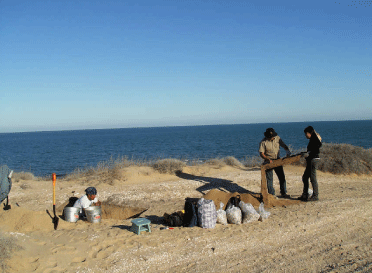
Work at the head of the Gulf of California. Image used by permission of Antonio Porcayo.
David Phillips
Northwest Sonora—the area west of the Concepción drainage basin and east of the Colorado River delta—is hot, dry, and barren. Most sites cluster along the coast or in the Sierra Pinacate. Trincheras culture sites end at Sonoita and the lower Rio Sonoita valley was uninhabited (Ives 1955). At the mouth of the Sonoita and west of that river, Lower Colorado Buff Wares predominate (Ezell 1955; Gifford 1946). Those wares are attributed to prehistoric Yuman speakers but historic patterns also hold for the prehistoric period, the buff wares were trade vessels used by Piman speakers.
Coastal sites are middens that include shell, pottery, and flaked and ground stone tools (J. Foster 1975; Gifford 1946). The pottery includes Yuman, Hohokam, and Trincheras types. Most shell appears to be from food species (J. Foster 1975), indicating that the sites were primarily camps used for littoral foraging.
The Sierra Pinacate volcanic field provided an oasis of sorts in the desert behind the coast. According to Julian Hayden (1967, 1976), the local Archaic group began using pottery (obtained by trade) about A.D. 300. The pottery is typically Yuman or Trincheras, rarely Hohokam. After A.D. 1200, the Pinacateños began using only Lower Colorado Buff Ware.
The Pinacate sites were semipermanent camps around bedrock tanks, and included rock windbreaks and large rock alignment figures. Shell tools and debitage were used but shell ornaments are rare. Occupation of the Sierra Pinacate continued into historic times, as a single band of Tohono O'Odham (Papago) foragers.
At the northwest edge of Sonora, the Rio Colorado delta was home to Yuman-speaking groups in historic times (Alvarez de W. 1985). Thanks to rescue archaeology (Porcayo 2007–2009), we are getting our first looks at the local archaeology. In 2007, Antonio Porcayo excavated a burned granary at Las Huellas in the Algodones area west if Yuma. Based on radiocarbon dates, the granary probably dates to the end of the 1800s and is thus at the end of the local Yuman occupation. Plant remains included mesquite, squash, beans and maize, mixed with fragments of storage baskets. Other remains included cloth and Yuman pottery, the latter including some "stucco coat" examples. The metal included slip-cover cans (Porcayo 2009). The granary excavation confirms ethnographic accounts of the late persistence of Yuman aboriginal farming. (See Trenganza [1947] for a second account of agricultural storage in the general area.)

Work at the head of the Gulf of California. Image used by
permission of Antonio Porcayo.
Key link:
Yuman pottery (plain)
Key link:
Yuman pottery (decorated)